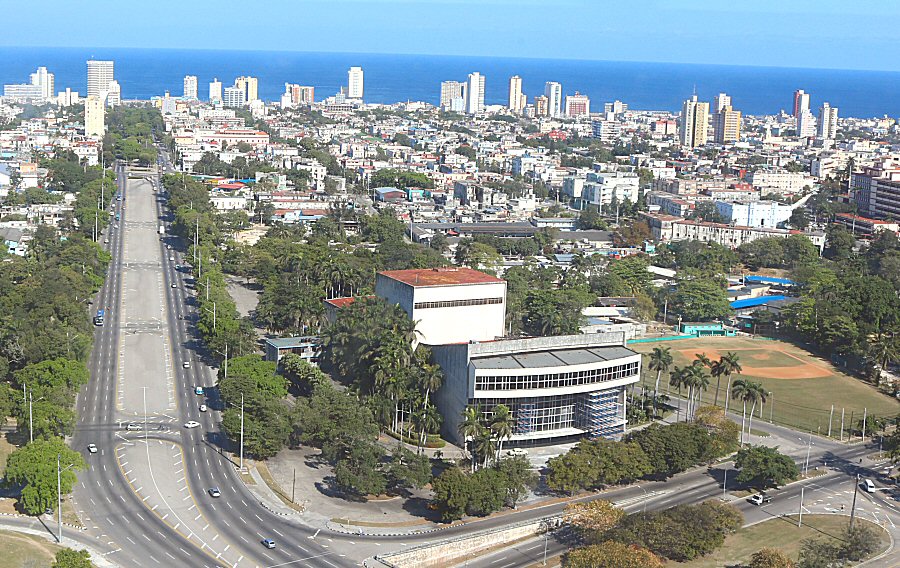

There are two art galleries in the building in that the
national and international works of the visual arts are
exhibited: Galería René Portocarrero and Galería Avellaneda.
Both the galleries occupy the Sala Covarrubias and the Sala
Avellaneda respectively.
The Teatro Nacional de Cuba is also a space where the garden and
the interior of the building are adorned by the
sculptures and murals of important Cuban artists. Many of them were
awarded in the contest to select the preliminary design of the
building in 1951. Some of them were added to the collection in
the reopening on the occasion of Havana Summit in 1960. There
are also works of renowned Cuban artists, donated to the Teatro
Nacional de Cuba in the period of 1970s and 1980s.
The garden of the theatre made a name
not only for the beautiful, exuberant and varied Cuban flora,
but also for the sculptures of the masters of the art, like
Rita Longa, Roberto Estopiñán, Alfredo Lozano Peiruga and
Tomás Oliva. The modern sculpture Muerte del Cisne (Death of the
Swan), made of stone of chaplaincy by Rita Longa, and the modern
stone sculpture La Crisálida (the Chrysalis) by the Cuban artist
Alfredo Lozano Peiruga (since 1959) are the most striking art
works in the garden. The metal sculpture of Osneldo García,
placed in the garden in 1979, is erotic, but festive. The murals
in the garden belong to Raúl Martínez, whereas the mural in Sala
Covarrubias is the work of René Portcarrero that devoted his
main activity to the murals in the theatre. Four of the five
murals in the theatre belong to him.
The interior design was developed by Zilia Sánchez. The
wood carving, Majagua II, is the work of Rita Longa. The metal
sculpture by José A. Díaz Peláez and the tapestry brocade by
Humberto Peña are the other outstanding pieces of the collection
of the theatre. The theatre has also a large collection of Cuban
painters: Puerta al Sueño (Door to Sleep) by Flavio Garciandía,
Sin Titulo (Without Title) by Gustavo Acosta, Triángulo de las
Bermudas by Rogelio López Marín and the pen drawing by Gilberto
Frómeta. The painting of Pedro Pablo Oliva also should not be
forgotten to mention here.
The 9th floor of the central tower of the Teatro Nacional
de Cuba serves as a multipurpose space that is used for
experimental theater performances, high-level, specialized
workshops, rehearsals and video recordings. Its magnificent
planking allows to the creators the best possibilities of highly
creative shows.
The Singer Café "Mi Habana" on the ground floor of the
National Theater of Cuba that can be entered from the side door,
is a dance hall, an ideal place to listen to authentic Cuban
music particularly at night.
The Piano Bar “Delirium Habanero”, since 1996, is located
on the top floor of the theatre that has wonderful views of the
Plaza de la Revolución. The place was characterized by variety of its shows, but
in recent years new strategies are formulated to rescue
traditional Cuban music from its most diverse forms (open until
the morning, 5 CUC-1 drink).
The Teatro Nacional de Cuba has a good organized
Documentation Center Maria de los Angeles Lastayo y Margolles
that was created in 1982. Dr. Maria de los Angeles Lastayo y
Margolles devoted the last 15 years of her life to collect of
valuable documents related with performing arts and shows,
mainly the theater and the dance. The center, unique in the
country, aims to become a teaching unit by offering a wide range
of documents, published and unpublished.
Within the activities of the Teatro Nacional de Cuba,
courses and workshops are organized that pursue the personal and
professional development of all those who participate, from
small children to adults.